There are many factors to consider before buying solar panels for your van. And of course, there’s no one-size-fits-all solution… which can make things a bit overwhelming. 🧐
However, if you want to achieve electrical independence in your motorhome, you don’t have much choice but to dive into the world of solar power.
Harnessing the sun’s energy is the key to generating electricity for your devices and gaining the freedom to live off-grid for as long as you desire. ⚡
But how do you choose the right solar panels for your setup? What wattage do you need? And what are the best solar panels for RVs and camper vans?
💡 To help you estimate your daily energy needs and properly size your auxiliary batteries and solar panels, we’ve created a free tool: an electrical autonomy simulator. We highly recommend trying it out after reading this guide!
By the end of this guide, you’ll know:
- Whether or not you need to install solar panels on your motorhome (spoiler: it’s not for everyone);
- The key electrical components required to set up a solar panel system in your van, RV, or camper;
- How a solar-powered electrical system works in a van;
- How to calculate your energy consumption;
- Our top tips for choosing the right solar panel (including what wattage to pick);
- Illustrated examples to help you visualize your setup;
- And, of course, plenty of tips and tricks.
Here’s everything you need to know about solar panels for vans! 😀
Why Are Solar Panels Essential for Your Van or Motorhome?
The Case for Off-Grid Living (Our Top Choice)
The so-called « off-grid lifestyle » is attracting more and more people. And for good reason: it’s an excellent way to escape the stress of conventional life while significantly reducing your energy costs.
To live off-grid, some choose a nomadic lifestyle: van life. 🚐
To embrace this off-grid lifestyle in a camper van, having a renewable energy source is essential. This will allow you to keep your fridge stocked with cold food (including your beers 🍺), charge your phone batteries, and even power your water pump.
But of course, installing solar panels isn’t just for those looking to live on the fringes of society. Let’s take a closer look.
The Case for Digital Nomads (Our Second Choice)
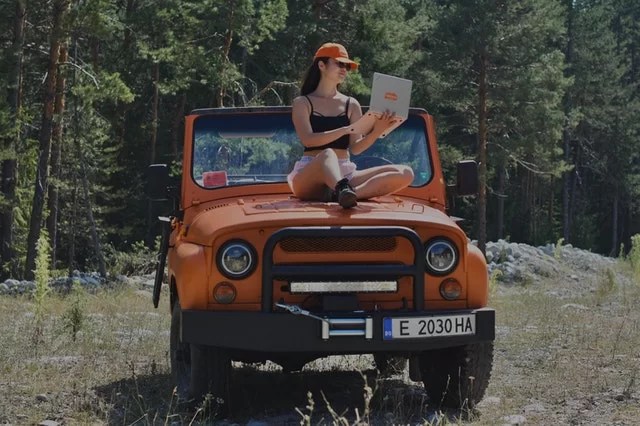
Maybe you’re planning to buy a van to live in full-time and fund your travels by working remotely from your laptop. In that case, you’ll become a digital nomad. 👍
If you’d like to learn more about this lifestyle, check out our step-by-step guide on how to become a digital nomad.
It’s a fantastic goal! 👨🏫
(And we’re not just saying that because it’s our goal too.)
However, for this dream to work, you’ll need to be able to power all your electronic devices throughout the day.
Especially your laptop and phone. 💻
If you don’t want to spend money on coffee shops, coworking spaces, or campground electricity every day, installing a solar power system could be the perfect solution.
Solar Panel Installation: A Step-by-Step Setup Guide

Our setup is straightforward. We have a 385-watt solar panel connected to our MPPT charge controller.

Next, our MPPT charge controller is connected to our Creabest lithium battery. By the way, if you’d like to learn more about this battery, feel free to check out our detailed review.

As you can see in the screenshot of our electrical diagram above, we also have a DC/DC charger. On one side, it’s connected to our auxiliary battery, and on the other, to our starter battery. This way, when we’re driving, our starter battery is recharged via the alternator.
This DC/DC charger is a 30A model. In theory, this means that if we drive for 1 hour, our 100Ah auxiliary battery will recharge by 30% (30Ah). So, if our battery was at 50% before leaving, after just one hour, it’ll be at 80%.
From our Creabest battery, we power our electrical panel, which in turn supplies electricity to all our devices.

As you can see, installing solar panels on an RV or van isn’t as complicated as it might seem. Far from it, actually. Especially once you know exactly what you need.
How Do Solar Panels Work? Everything You Need to Know

Solar panels on vans convert the energy from the sun into electricity.
Each panel is made up of a set of photovoltaic cells. These cells are what transform sunlight into electricity. ⚡
Once the electricity is generated, it can be stored in one or more batteries, depending on your needs. This makes solar power an excellent solution for powering your devices. 🤳
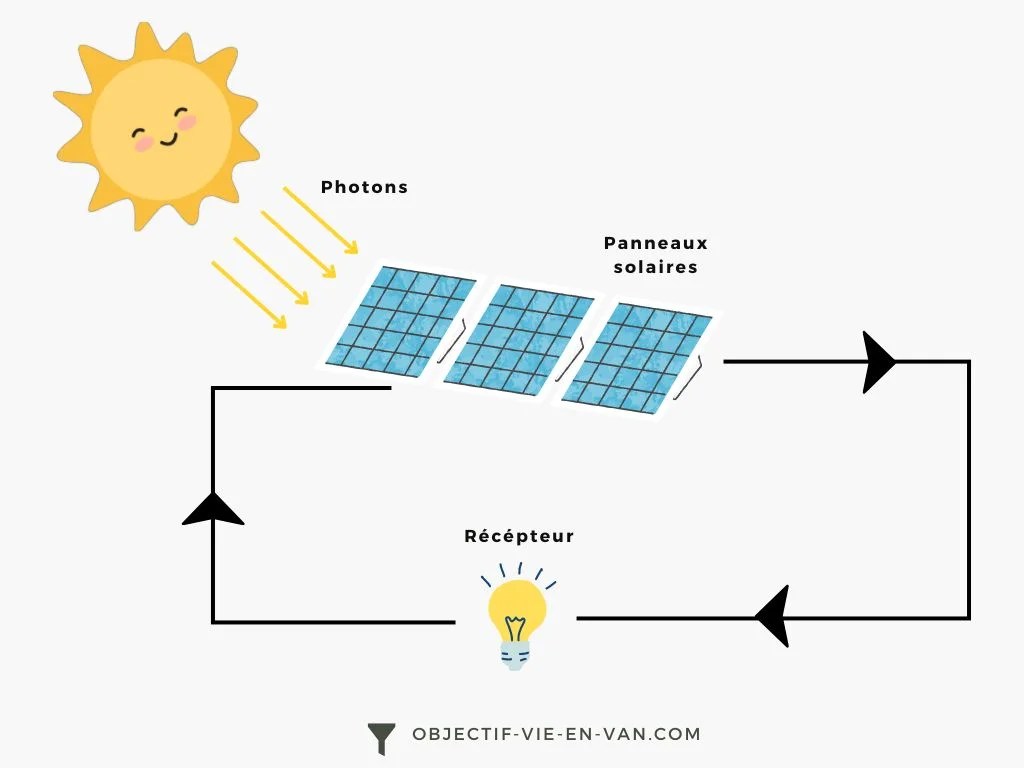
However, sunlight is variable.
It changes depending on several weather-related factors (seasons, cloud cover, the sun’s position in the sky, etc.), as well as environmental factors (e.g., shadows from buildings or trees). 🌳
As a result, solar panels produce electricity with irregular voltage.
The solution? You need a charge controller to regulate the solar energy. ☝
So, whether it’s for a van, RV, or motorhome, a solar-powered electrical system consists of four key components:
- The Solar Panel: This is what generates electricity. Depending on your needs, you can have multiple panels—we’ll talk more about this later in the guide.
- The Wiring: This transfers the energy produced by your van’s solar panel to other components (like your auxiliary battery, for example).
- A Charge Controller: This is essential for regulating the voltage/current coming from your solar panel.
- A Battery Bank: We say « bank » because it’s always good to have multiple batteries, but if your needs are minimal, a single battery might suffice. In our camper van, Hermès, we have two.

How to Size Your Solar Panels: What Wattage Do You Need for an RV or Van?
By answering this question, you’ll be able to determine what type of solar panel is best suited for your needs and how many you’ll require. 👍
The amount of energy you need depends primarily on your lifestyle.
In this section, we’ll cover:
- Watts (W);
- Watt-hours (Wh);
- And Amp-hours (Ah).
Watts (W): This is the unit of measurement for electrical power. We’ll mostly talk about Watt-hours (Wh), which refers to the amount of energy consumed over time (a 65W device will consume 65Wh in one hour).
Amp-hours (Ah): This is the unit of measurement used to indicate the capacity of your battery. It represents the amount of energy a fully charged battery can deliver under normal conditions at 20°C for one hour.
⚠️ Important: Always add 20% to your calculations. This will help you account for unexpected situations.
💡 Did you know? You can easily calculate the required solar power and storage space for your setup using our simulator.
Step 1: List Your Electrical Devices and Calculate Your Energy Needs
What electrical devices will you be bringing with you? 🤔
List them all in an Excel file. For each device, note its power rating (in W) and its estimated usage time (in hours).
💡 To find the power rating (in W) of an electrical device, simply check the label on the device itself. At the very least, you’ll find the current (A) and voltage (V), which you can multiply together to calculate the power.

For example, Johanna’s phone uses a 22.5W charger to recharge its battery. On my end, I use an 80W charger (see photo above).
Compile this data in an Excel file:

Fun fact: You’ll notice that over 24 hours, Johanna actually consumes more energy than I do. Even though her charger is less powerful, she needs more time to recharge, and her phone battery drains faster. As a result, she’s plugged in more often.
This is why the time factor is so important to consider. ⌚
Now it’s your turn! List all your electrical devices and calculate their daily energy consumption.
Here’s what it looks like for us:

Our daily energy consumption is 1,588 Wh/day, which is well above average.
If we take a closer look, the main culprit is « Gab’s Laptop. » It’s the biggest energy hog. It’s not really suited for a nomadic, minimalist lifestyle or van life in general. 👎
But don’t blame it too much. The issue is that its battery is dead, so it needs to stay plugged in all the time to work.
When it finally gives up the ghost and I’m forced to buy a new one, it’ll hurt my wallet but do wonders for our daily energy consumption! 😃
(We’ll go from 1,588 Wh/day to 835 Wh/day.)
Update: Our daily consumption is now closer to 500–600 Wh/day.
We no longer have the old laptop. After many months of traveling in our van, our daily energy consumption now averages around 500–600 Wh/day.
Step 2: How Many Solar Panels Do You Need for Your Camper Van? And What Wattage?
Now that we’ve calculated our daily energy consumption, we can move on to the star of the show: choosing the right solar panels for your van. ⚡
This will depend on your lifestyle choices. Are you planning to:
- Travel full-time;
- Or only hit the road during the warmer months?
Case #1: Sizing Your Solar Panels for Year-Round Use
When it comes to electricity, it’s always better to plan for the worst-case scenario.
In other words, you need to choose solar panels that will provide the most energy during the least favorable time of the year: December.
In December, it’s estimated that a solar panel delivers its maximum power output for about 1 hour per day.
This means that a 100W solar panel will provide 100W/day in December.
What matters in your setup is the total power output of your solar panel array. That is, the power of an individual solar panel multiplied by the number of panels you have.

How much solar energy do I need? 100W? 300W?
Let’s revisit our camper van’s energy consumption as an example:
- After updating this article, we consume around 550 Wh/day.
- If we divide this consumption by 12V (the voltage of our electrical system), we get 45 Ah.
- This result represents the minimum capacity our battery bank should have (a 100Ah lithium battery will give us 2 days of autonomy).
It’s from this capacity that we can calculate the required power for our solar panels.
Here’s the thing: It’s not the solar panels that power your devices directly—it’s the batteries. Your solar panels charge your battery bank, which then powers your devices.
This means we’ll need multiple solar panels to generate enough energy to cover our needs. Specifically, two 385-watt panels could provide sufficient electricity even in December.
However, this assumes you have enough space on your van’s roof—which we don’t.
Plus, once the sunny season arrives, a solar panel can deliver its maximum power output for 3 to 5 hours per day. With this setup, we’d be able to generate up to 3,850 Wh/day. That’s way more than we need!
The solution is to size your system slightly smaller and install a DC-DC charger to recharge your batteries while driving.
We opted for a 30A DC-DC charger.
This way, in summer, you won’t generate more energy than necessary. And in winter, the DC-DC charger will cover the rest of your energy needs while you’re on the road.
Case #2: Sizing Your Solar Panels for Seasonal Use
When sizing your solar panels for year-round use, you base your calculations on the worst month (December). For seasonal use, it’s the same principle—you base your calculations on April, May, or September.
As we’ve just seen, during the sunny season, a solar panel is estimated to deliver its maximum power output for about 3 hours per day in the worst-case scenario.
This means that a 100W solar panel will provide an average of 300 Wh/day.
To cover our daily consumption of 550 Wh, we’d need one 385-watt solar panel. This would provide between 1,155 Wh/day and 1,925 Wh/day.
That’s a bit more than necessary, but it’s always good to plan for the unexpected.
Step 3: Sizing Your Camper Van’s Auxiliary Batteries

By now, you know your daily energy needs and how to size your solar panel array.
Next, let’s do the same for the storage capacity of the electricity you’ll generate with your system.
Battery capacity is measured in amp-hours (Ah). The calculation is the same whether you have an AGM, GEL, or lithium battery.
To determine the capacity you’ll need, simply divide your daily energy consumption by the voltage of your electrical system. For most people, this is 12V, but some have a 24V system.
In our example, that’s: 550 Wh/day ÷ 12V = 45 Ah/day.
However, you should never fully drain a battery (except for lithium batteries). So, for AGM or GEL batteries, multiply this result by 2 (to double the battery capacity). In our case, we’d need a battery with a capacity of 90 Ah.
Here’s the full calculation for sizing your van’s electrical storage system for AGM or GEL batteries:
Minimum Battery Capacity = Daily Energy Consumption ÷ System Voltage × 2
And here’s the full calculation for sizing your van’s electrical storage system for lithium batteries:
Minimum Battery Capacity = Daily Energy Consumption ÷ System Voltage × 1.2
In Hermès, we have two 100 Ah batteries, totaling 200 Ah. It’s not quite enough right now, but in the long term, we won’t have my power-hungry laptop anymore. So, 200 Ah will become more than sufficient.
That said, it’s worth noting that on weekends, we don’t always use our laptops. Similarly, we don’t charge our Kindle every day (once a month), our camera (twice a week), or our drone (twice a week).
What’s the Best Solar Panel for Powering a Camper Van?
By now, you know:
- How much energy you need to power your electronic devices;
- How many solar panels you need on your van’s roof and what their power output (in W) should be;
- How to size your auxiliary batteries (with storage capacity measured in Ah).
We’ll say it again: This guide won’t cover the installation of your solar-powered electrical system. We’ll save that for another article.
But keep in mind that you’ll still need to install a charge controller, size your cables and fuses, set up a DC-DC charger, and more. In short, there’s still work to do. 😉
Now, what’s the best solar panel for powering your camper van?
Well, there’s no one-size-fits-all answer. It depends on the needs you’ve just calculated, your budget, and the shape of your vehicle.
There’s no « best solar panel. » However, by asking the right questions, you can narrow down your options to find the one that best suits your nomadic lifestyle.
What Are the Two Most Common Types of Solar Panels Used in Vans, RVs, and Camper Vans?
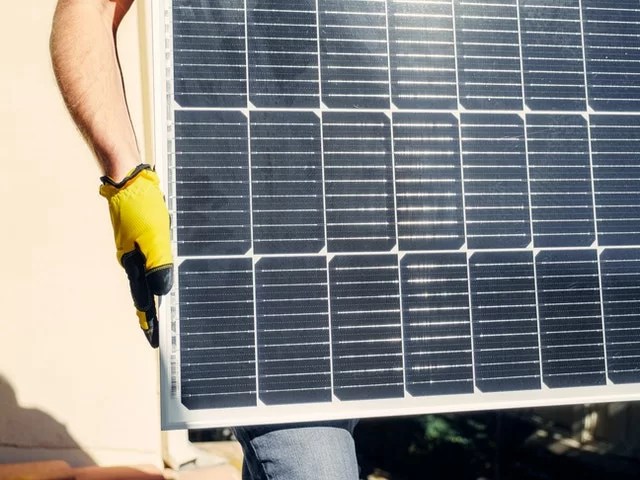
The most commonly used solar panels for van, RV, and camper van setups are monocrystalline and polycrystalline panels.
For the record, both are excellent choices. However, there are a few small differences that might make you prefer one over the other.
Type #1: Monocrystalline Solar Panels (The Most Popular Choice)
- It has a black hue;
- Made from a single silicon crystal, making it, by definition, more efficient than its polycrystalline counterpart;
- It’s noticeably more expensive than polycrystalline solar panels.
Type #2: Polycrystalline Solar Panels
- It has a bluish hue;
- Made from silicon scraps left over from the production of monocrystalline panels. These scraps are melted together, making it, by definition, less efficient than its monocrystalline counterpart;
- It’s noticeably cheaper than monocrystalline solar panels;
- While polycrystalline solar panels produce less energy than monocrystalline ones, they are still highly durable. So, if you’re on a tighter budget for your solar power system, they can be an ideal solution.
It’s worth noting that there are even cheaper solar panels: amorphous panels. We won’t go into detail about them in this guide because they’re far less efficient than the two types we’ve just discussed.
In fact, they’re not at all suited for van life! For your camper van, stick to monocrystalline and polycrystalline solar panels.
Should You Choose Flexible or Rigid Solar Panels?
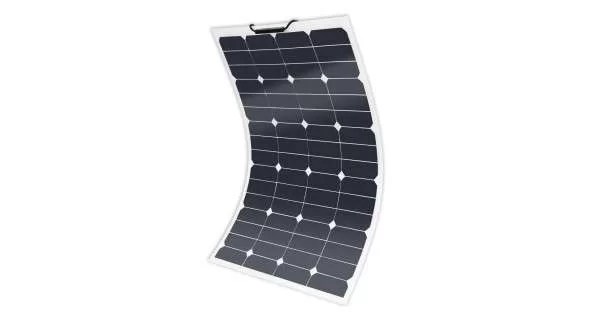
Within all types of solar panels, you’ll find both flexible and rigid options.
We tend to recommend rigid panels.
While they’re bulkier, they’re also more durable. Plus, their mounting systems elevate them slightly above the roof, which promotes better airflow and reduces the risk of overheating (which can lower production).
That said, for reasons of discretion or because your van’s roof shape doesn’t allow for rigid panels, you might prefer the flexible option.
Which Solar Panel Should You Choose for Your Camper Van? (5 Key Factors to Consider)
By now, you know a lot more about solar panels. All that’s left is the final step: making your choice.
To help you out, here are a few key factors to consider to ensure you don’t make a mistake:
- The required power output (in Watts);
- The brand;
- The type of panel;
- The features;
- The price.
Factor #1: The Power Output of the Solar Panel

We’ve already done a lot of the heavy lifting for you earlier in this guide.
By listing your devices, you’ve created what’s called an energy audit. This allowed you to size your battery bank and determine the power output needed for your solar panel array.
💡 If you haven’t done this yet, take 2 minutes to use our electrical simulator.
To recap, with all our devices, we have an energy requirement of 1,588 Wh/day. But that’s only because we have a power-hungry, end-of-life laptop.
The goal is for your solar panels’ production to exceed your energy needs.
In general, two solar panels with 200 to 300W each are MORE than enough to make you energy-independent. In winter, you’ll produce 400 to 600 Wh/day, and in summer, you’ll produce 1,200 to 1,800 Wh/day.
By the way: There’s no need to oversize your system. Especially if you don’t plan to travel year-round. You’ll end up overproducing, and the excess energy won’t be stored in your batteries.
Factor #2: The Brand of the Solar Panel—Which Manufacturer Should You Choose?
As with anything, there are several brands of solar panels. Some offer very attractive prices, while others aim to inflate their revenue.
Who should you trust? Where should you buy? Big questions!
What you absolutely want to avoid is having to replace your solar panel system every 2 to 5 years. Ideally, it should last for over 20 years of travel.
So, avoid Chinese brands and opt for European brands (with the « CE » marking). This will ensure that the equipment you’re buying meets standards and complies with all regulations.
Among the good brands, you’ll find:
- Victron Energy;
- Uniteck solar panels;
- DualSun;
- SunPower (which offers the best warranty).
Factor #3: What Type of Solar Panel for a Camper Van? Polycrystalline OR Monocrystalline? Rigid OR Flexible?
Once again, we’ve done some of the work for you by explaining that there are two main types of solar panels:
- Polycrystalline;
- Monocrystalline.
To recap, monocrystalline panels are the preferred choice. Although more expensive, they offer higher efficiency and perform better in low-light conditions.
That said, if your budget doesn’t allow for it, polycrystalline panels will work just fine—especially if they cover a large area.
Next, solar panels can be:
- Rigid;
- Flexible.
Flexible solar panels offer more discretion, don’t add extra height to your camper van, and adapt perfectly to non-flat roofs. However, they have limited power output, a shorter lifespan, and are more expensive.
Rigid panels are the opposite. They’re thicker and sit more than 2 cm above your vehicle’s roof, so you lose some height and discretion. On the plus side, they have better power output, a longer lifespan, and are more affordable.
Factor #4: What Features Should You Look for When Choosing a Solar Panel?

While browsing through different manufacturers’ catalogs, you’ll come across some gems. But don’t stop there—dig deeper. We highly recommend doing so.
Here’s what you should pay attention to:
- Warranty: A higher price doesn’t always mean better reliability. A solar panel that costs €800 isn’t necessarily better than one that costs €250. Prioritize longer warranties.
- Size: If you have plenty of space on your camper van’s roof, you can opt for a polycrystalline panel instead of a monocrystalline one. Since polycrystalline panels perform well over large areas, you’ll save on budget.
- Panel Efficiency: Due to energy losses, efficiency will never be 100%. It typically ranges between 7% and 24%.
- Temperature Coefficient (Isc, Voc, Pm): Temperature negatively affects your panels’ efficiency. The lower the temperature coefficients, the better.
- Performance Warranty: Check the performance guarantees offered by manufacturers. This isn’t always stated, but on average, after 20 years, a solar panel’s productivity decreases by 8.2%. This is an important factor to consider, as not all solar panels have the same performance guarantees.
Factor #5: The Price of a Solar Panel for a Camper Van
By now, you should have a shortlist of solar panels that perfectly match your van conversion and energy independence goals.
The only thing left to consider is which one fits your budget.
To do this, take the price of a solar panel from your list and divide it by the number of watts it can produce. For example, a 440W panel priced at €425 works out to €0.96/W, while a 375W panel priced at €195 works out to €0.52/W!
To ensure you’re getting the best deal, pay close attention to these calculations and test different combinations. It might even be cheaper to buy three 100W panels instead of one 300W panel.
2 Tips and Tricks Before Choosing the Solar Panel for Your Camper Van
Tip #1: Pay Attention to Size
Make sure your solar panels can actually be installed on your camper van’s roof.
It might seem obvious, but when you spend hours searching for the perfect solar panel and get lost in technical specifications, it’s easy to overlook the basics.
And trust us, many people only realize this during installation.
Tip #2: Replace Your Energy-Hungry Devices
Some of your electrical devices consume way too much energy. As mentioned earlier in this guide, my laptop is a prime example.
Admittedly, it’s not easy to replace because it means spending a lot of money. But even without going that far, we’ve already significantly limited its use.
For other devices, like lights, look for the most energy-efficient options. Opt for LEDs, for example.
This will drastically reduce your energy consumption.
5 Benefits of Installing Solar Panels on Your Camper Van
Solar energy offers numerous advantages when it comes to powering your camper van’s electrical system.
1. Electricity is Free

Once installed and wired on your roof, your solar panels require very little maintenance to function.
As long as the weather is favorable, they’ll provide you with free energy for years. You can’t say the same about other energy sources!
2. Solar Energy is Clean
Unlike generators that require gasoline to operate, a solar-powered electrical system is entirely clean and renewable (aside from the manufacturing of the solar panels, batteries, etc.).
Plus, adding solar panels to your recreational vehicle is an investment in the green energy industry, helping to drive its development!
3. Choose an Off-Grid Lifestyle

As we mentioned earlier, if you want to live off-grid in your van, solar energy is the way to go.
There’s nothing better than relying on your own photovoltaic system and nature to recharge your batteries, power your lights, and keep your beers cold. 🍺
Even in bad weather, solar panels can still capture some of the sun’s energy. So, if you choose the right auxiliary batteries, size your panels correctly, and have a DC-DC charger, you might not even need to recharge for several days.
4. Solar Panels and Their Durability
Between the speed, vibrations, and shocks from the roads and trails you’ll travel, it’s fair to wonder if installing solar panels on your van is a good idea.
Turns out, it is. 👍
Solar panels are becoming increasingly durable, and contrary to what you might think, they’re not overly sensitive to vibrations. In fact, they handle traveling with you from region to region and country to country just fine.
Additionally, most panels are built to withstand years of sun, wind, rain, snow, and even hail. ⛈
The lifespan of solar panels is 20 to 25 years (or more). By then, they’ll likely follow you to your next van conversion!
FAQ: Everything You Need to Know About Solar Panels for Camper Vans
The wattage of the solar panel for your camper van depends on your daily energy needs. A common estimate is 100 to 200 watts for basic needs. But if you’re aiming for energy independence, aim for a panel with over 350 watts.
Yes, it’s possible to be energy independent with a well-designed solar panel system. However, it also depends on your energy consumption and weather conditions. These are factors you should consider in your calculations.
The choice between monocrystalline and polycrystalline depends on your budget. Monocrystalline panels are generally more efficient but also more expensive. That said, if your goal is energy independence, we strongly recommend monocrystalline panels.
Solar panels aren’t the most expensive part of an electrical setup. The price of a solar panel for a van varies depending on its wattage and type. Expect to spend between €100 and €500 for a high-quality panel. We bought our 385-watt panel for €245.
To maximize efficiency, make sure your panels are always clean and facing the sun. You can even build a structure to tilt them at a 30-degree angle when parked. Using an MPPT charge controller can also help optimize energy production. Avoid PWM controllers, even though they’re cheaper.
We’re talking about capacity, not power. And it depends mainly on your energy needs. For us, a single 100Ah lithium battery is enough, even though we work full-time in the van (two laptops, two phones, a 4G router, and lights). You can estimate your needs using our simulator.
And there you have it! You now know how to:
- Understand how a camper van’s solar panel system works;
- Calculate your daily energy consumption;
- Size your solar panel array;
- Size your battery bank;
- Make the right choice for the ideal solar panel.
Now it’s your turn to take action!
If you have any questions or additional information to add to this guide, feel free to share it in the comments section below 👇





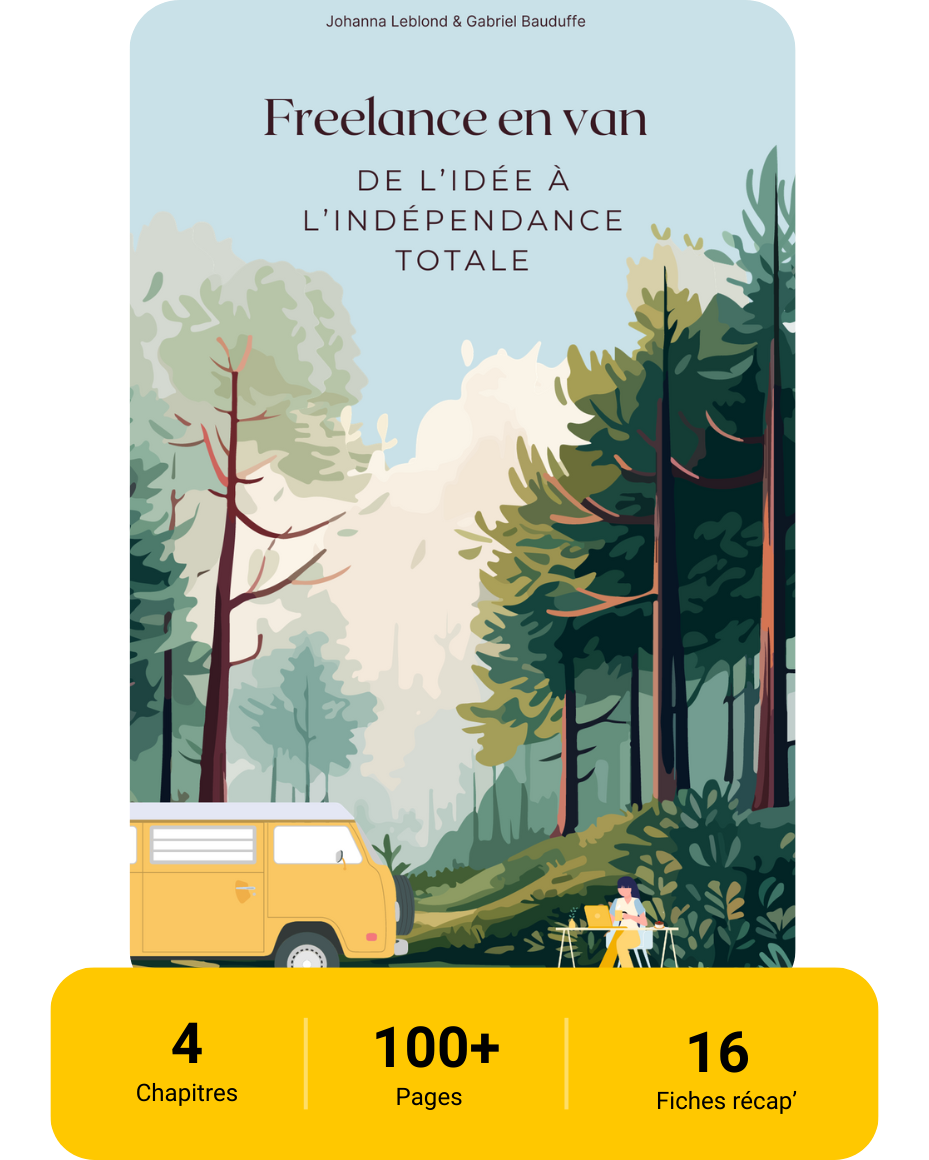

0 commentaires